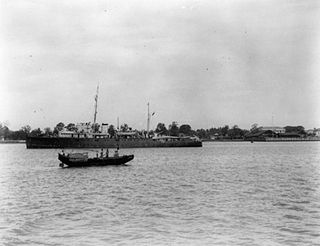
The Royal Indian Navy (RIN) was the naval force of British India and the Dominion of India. Along with the Presidency armies, later the Indian Army, and from 1932 the Royal Indian Air Force, it was one of the Armed Forces of British India.

Maritime powers in the Indian subcontinent have possessed navies for many centuries. Indian dynasties such as the Chola Empire used naval power to extend their influence overseas, particularly to Southeast Asia. The Marakkar Navy under Zamorins during 15th century and the Maratha Navy of the Maratha Confederacy during the 19th and 18th centuries fought with rival Indian powers and European powers. The East India Company organised its own private navy, which came to be known as the Bombay Marine. With the establishment of the British Raj after the Indian Rebellion of 1857, the small navy was transformed into "His Majesty's Indian Navy", then "Her Majesty's Indian Marine", and finally the "Royal Indian Marine".

Naval trawlers are vessels built along the lines of a fishing trawler but fitted out for naval purposes; they were widely used during the First and Second World Wars. Some, known in the Royal Navy as "Admiralty trawlers", were purpose-built to naval specifications; others were adapted from civilian use. Fishing trawlers were particularly suited for many naval requirements because they were robust vessels designed to work heavy trawls in all types of weather, and had large clear working decks. A minesweeper could be created by replacing the trawl with a mine sweep. Adding depth charge racks on the deck, ASDIC sonar below, and a 3-inch (76 mm) or 4-inch (102 mm) gun in the bow equipped the trawler for anti-submarine duties.
Naval trawlers were purpose-built or requisitioned and operated by the Royal Navy (RN), mainly during World Wars I and II. Vessels built to Admiralty specifications for RN use were known as Admiralty trawlers. All trawlers operated by the RN, regardless of origin, were typically given the prefix HMT, for "His Majesty's Trawler".

HMIS Indus was a Grimsby-class sloop of the Royal Indian Navy launched in 1934 and sunk during the Second World War in 1942. She was a slightly enlarged version of other vessels in the Grimsby class. She was named after the Indus River. Indus served mainly as an escort vessel, and she was therefore lightly armed. Her pennant number was changed to U67 in 1940.

HMS Puffin (L52), was a Kingfisher-class sloop of the British Royal Navy, built in the 1930s, that saw service during World War II. The ship was laid down on 12 June 1935 by Alexander Stephens and Sons, based at Linthouse in Glasgow, launched on 5 May 1936, and commissioned on 6 August 1936.
HMIS Kathiawar (J155) was a Bangor-class minesweeper built for the Royal Navy, but transferred to the Royal Indian Navy (RIN) during the Second World War.
HMIS Khyber (J190) was a Bangor-class minesweeper built for the Royal Navy, but transferred to the Royal Indian Navy (RIN) during the Second World War.
HMIS Kumaon (J182) was a Bangor-class minesweeper built for the Royal Navy, but transferred to the Royal Indian Navy (RIN) during the Second World War.
HMIS Carnatic (J182) was a Bangor-class minesweeper built for the Royal Navy, but transferred to the Royal Indian Navy (RIN) during the Second World War.

HMIS Hindustan (L80) was a Folkestone-class sloop which served in the Royal Indian Navy (RIN) during World War II. Her pennant number was changed to U80 in 1940.
HMIS Rajputana (J197) was a Bangor-class minesweepers built for the Royal Navy, but transferred to the Royal Indian Navy (RIN) during the Second World War.
HMIS Konkan (J228) was a Bangor-class minesweepers built for the Royal Navy, but transferred to the Royal Indian Navy (RIN) during the Second World War.
HMIS Madras (J237) was a Bathurst-class minesweeper that served in the Royal Indian Navy (RIN) during World War II.

Vice Admiral Nilakanta Krishnan, PVSM, DSC, was a former flag officer in the Indian Navy. He was the Flag Officer Commanding-in-Chief Eastern Naval Command during the 1971 Indo-Pakistani War.

The Basset class of Admiralty trawlers was a class of trawlers built for the British Royal Navy prior to the outbreak of Second World War. The vessels were intended for use as mine-sweepers and for anti-submarine warfare, and the design was based on commercial types, adapted for naval use. The purpose of the order was to make use of specialist mercantile shipyards to provide vessels for war use by adapting commercial designs to Admiralty specifications.

Vice Admiral Swaraj Parkash, PVSM, MVC, AVSM was a Flag officer in the Indian Navy. He was the Captain of the aircraft carrier INS Vikrant during the Indo-Pakistani War of 1971 for which he was decorated with India's second-highest military decoration, the Maha Vir Chakra. He later served as the second Director General of the Indian Coast Guard from 1980 to 1982.
HMIS Agra (T254) was a minesweeping trawler of the Royal Indian Navy, one of twenty-two built to the design of the Royal Navy's Basset-class during the Second World War. She was laid down in November 1940, and launched in April 1942, serving until her decommissioning in 1946.








